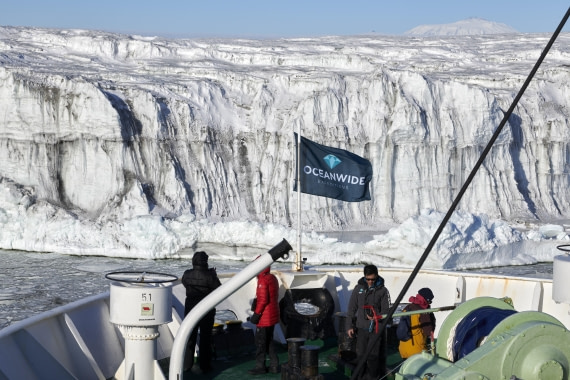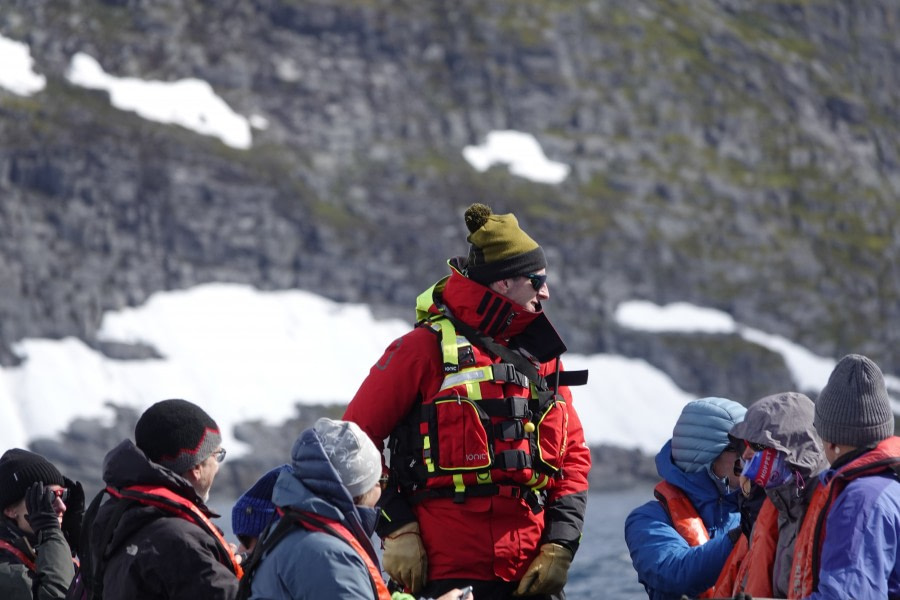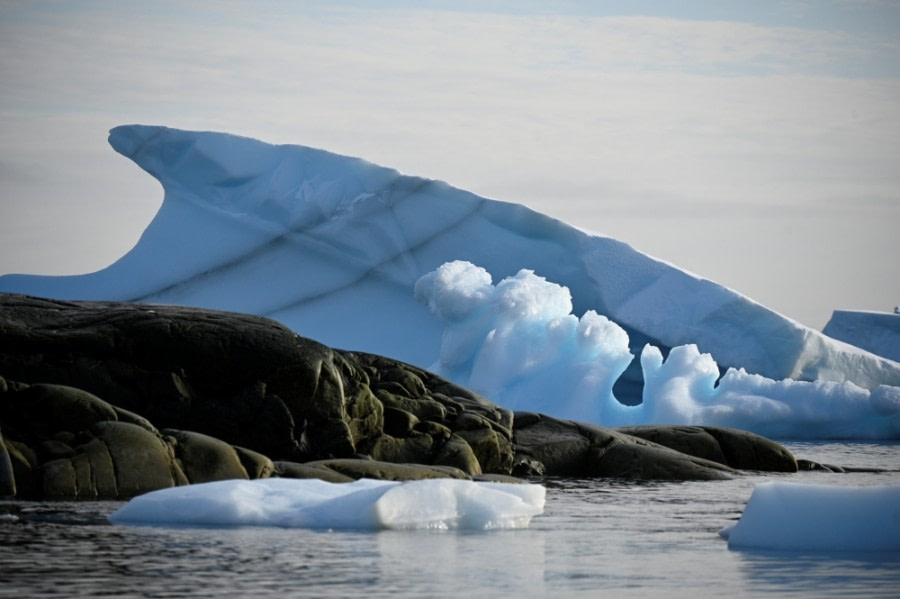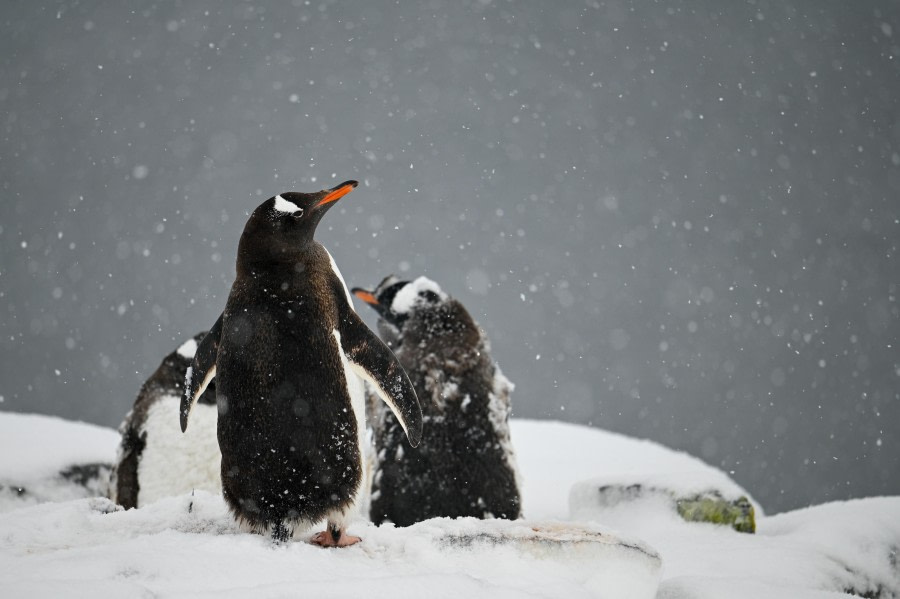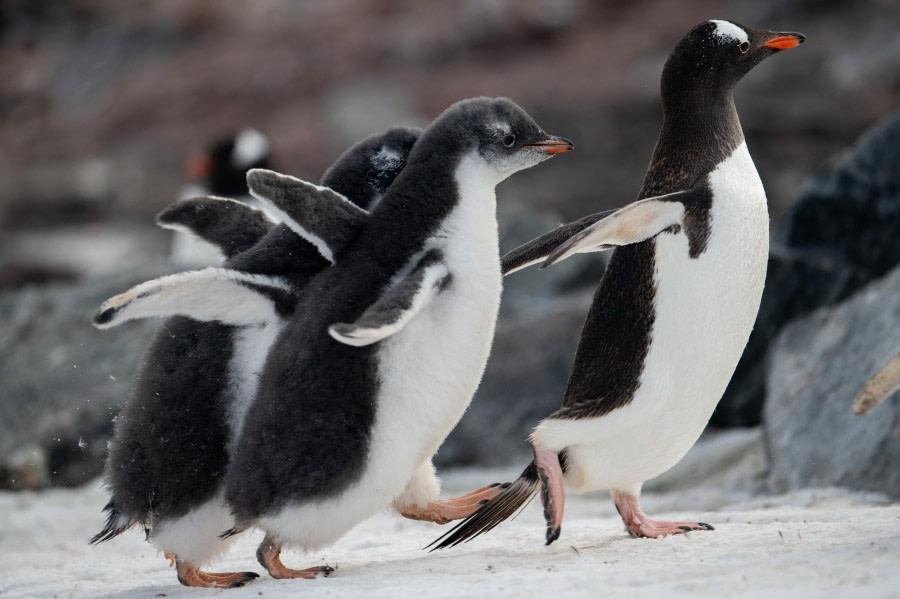The Ross Sea is a giant bay found south by south-east from New Zealand. Home of at least 10 species of mammal, 6 dozen species of birds, nearly a hundred types of fish, and around 1000 examples of invertebrate species. The Ross Sea is one of the few expanses of salt water that has been left (relatively) free of human impact.
Travellers to the Ross Sea are greeted by a massive geographical wonder – the Ross Ice Shelf. The shelf, roughly the size of France, is in fact part of a massive glacier that runs back onto the continent. The Shelf, referred to as the Ross Barrier by explorers like Shackleton and Scott, runs 700 km long at its northern end and towers 15-50 metres above the water.
Passengers aboard one of our Ross Sea Journeys will travel along the southern parts of the Antarctic Peninsula, Peter I Island, the Bellingshausen and Amundsen Seas into the Ross Sea. Visiting the Ross Ice-shelf, Dry Valleys, McMurdo Station, Campbell Island and the historic huts of discovery voyagers Scott and Shackleton. Ortelius will be equipped with helicopters. Be prepared for an unforgettable memory.

Momenteel hebben we geen Ross Sea cruises beschikbaar.
Video of Ross Sea expedition
Laatste blog en klantverhaal

De acht albatrossen van Antarctica en sub-Antarctica
Of je nu op weg bent naar Antarctica, de sub-Antarctische gebieden of een combinatie van beide, dit artikel geeft je alle belangrijke informatie over albatrossen en waar je deze vogels het beste kunt vinden.

The Most Epic Journey In The World: Ross Sea Antarctica
This expedition had everything – jaw dropping landscapes, whales galore, volcanoes, ice, ice and more ice of all kinds, berg, fast, sea, pancake, brash... forever sunsets, heroes, huts and of course, penguins...
Laatste hoogtepunt en wilde dieren

Bekijk de hoogtepunten die je kunt ervaren:

Bekijk de hoogtepunten die je kunt ervaren:
Map of the Ross Sea
Ross Sea photo
Ross Sea cruise reviews







The Gray Seal is cool







Ross Sea FAQ
Wat kan ik in de Ross Sea verwachten?
De Rosszee in Antarctica is een van de meest afgelegen plekken op aarde. Vanwege het gedurende een groot deel van het jaar aanwezig zijn van dik pakijs, wordt het gebied niet vaak bezocht door toeristen. Alleen de sterkste ijsversterkte schepen kunnen doordringen en veilig navigeren in dit hoog-Antarctische gebied.
Maar de beloningen zijn ernaar; de Ross Sea bezit een uitbundig dierenleven, ongelofelijke landschappen en bijzondere overblijfselen van heroïsche poolexpedities. Een aantal hoogtepunten zijn: enorme Keizerspinguïn en Adéliepinguïn kolonies, Mount Erebus, de Ross IJskap, de Droge Valleien, McMurdo Station, Kaap Evans (hut van Scott) en Cape Royds (hut van Shackleton).
Hoe is het weer in de Ross Sea?
Omdat de Rosszee onder de directe invloed staat van het zeer koude continentale Antarctische klimaat staat, is de gemiddelde temperatuur in het gebied laag, rond de 1 graad Celsius. In februari – maart, aan het einde van de zuidelijke zomer, kan de temperatuur zelfs onder nul zijn. Harde katabatische winden kunnen elk moment opzetten en een grote invloed op het programma hebben.
Let op: het pakijs vormt zich in de Rosszee al aan het begin van het winterseizoen en kan blijven liggen tot laat in de zomer. Hoewel we wel verwachten door te kunnen dringen in de Rosszee, is er geen garantie. Pakijs is onvoorspelbaar en kan verhinderen dat onze schepen het geplande programma geheel kunnen uitvoeren.
Wat voor kleding kan ik het beste meenemen op een reis naar de Ross Sea?
Omdat het in de Rosszee zeer koud kan zijn is het van groot belang om warme kleding mee te nemen. Een waterdichte jas en broek tegen de wind, sneeuw en regen maar ook tegen het zoute spatwater in de Zodiac zijn belangrijk. Daarnaast ook warme onderkleding zoals thermisch ondergoed, fleecejack, handschoenen, wanten en een warme muts. Een donsjas maakt het verblijf op het ijs bij de pinguïns een stuk comfortabeler. Rubberlaarzen zijn nodig voor de landingen maar worden uitgedeeld aan boord.
Hoe gaan we aan land tijdens de Ross Sea reis?
Er zijn geen havens in de Rosszee. De landingen gebeuren daarom per zodiac, een stabiele rubber boot, en met helikopters.
Waar bevindt de Ross Sea zich en hoe groot is het?
De Rosszee ligt in de Zuidelijke Oceaan tussen Marie Byrd Land en Victoria Land. De grote baai ligt bij de Amundsen Sea en maakt deel uit van het Antarctische gebied. Tijdens een expeditie cruise naar de Rosszee zullen we meerdere continenten en eilanden zien en bezoeken.
De Rosszee heeft een totaal oppervlak van zo’n 960.000 vierkante kilometer. De zee is relatief ondiep, op de meeste plekken is het er niet dieper dan zo’n 300 meter, alleen in het zuidwesten wordt een diepte bereikt van 914 meter. Nieuw-Zeeland heeft het gebied rond de Rosszee geclaimd. Deze claim wordt echter door de meeste landen niet geaccepteerd.
Wie ontdekte de Rosszee?
Het is niet met zekerheid te zeggen wie de Rosszee heeft ontdekt maar er wordt aangenomen dat in 1841 de Britse marineofficier James Clark Ross met de schepen HMS Erebus en HMS Terror vermoedelijk als eerste deze koude zee is binnengevaren. Het doel van de expeditie, het bereiken van de Magnetische Zuidpool, werd echter niet bereikt.
Fotogalerij
About the Ross Sea
Ross Sea weather
While temperatures during the Antarctic winter months can drop as low as around -50°C, you can expect slightly more comfortable temperatures around -10°C - 0°C during your Ross Sea cruise.

Facts about the Ross Sea
- A colossal squid measuring longer than 10 metres and weighing almost 500 kilograms was found in the Ross Sea in 2007.
- All the islands found within the limits of the Ross Sea have been claimed by New Zealand, although most countries don’t bother to recognise the claims.
- The Ross Ice Shelf is the largest such shelf on Earth. At approximately 472,000 km2 it is roughly the size of Spain. It soars anywhere between 15 and 60 metres high and extends nearly 800 kilometres along the shoreline.
- The Ross Sea is named after Captain James Clark Ross who mapped the area in the 1841.
- Since the Ross Sea is the open waterway closest to the actual South Pole it has become the launching spot of many exploration expeditions that went on to journey inland.
- The Ross Ice Shelf was the mother to what was quite possibly the biggest iceberg ever. The iceberg broke off of the shelf in the year 2000, measuring 295 km at its longest point and 37 km at its widest. Altogether it boasted a surface area of about 11,000 km2.
- Wildlife flourishes despite the harsh cold of the waters. Some of the fish found in the Ross Sea have antifreeze in their veins to keep them from freezing solid.
Travel to the Ross Sea
Travel to the Ross Sea and experience one of the most pristine untouched landscapes left in the world. Your Ross Sea expedition will be full of activities that let you take in the rugged and clean beauty of the area – hike the shores of Antarctica, visiti historical sites from the Golden Age of Exploration like the huts of explorers Shackleton and Scott, and enjoy unique helicopter flights to the Dry Valleys and the Ross Ice Shelf.
Your Ross Sea trip will also introduce you to a surprising abundance of wildlife. Go bird watching on the lookout for albatrosses and Petrels. Cruise along the shores in a Zodiac and say hello to seals and a variety of whales. Your Ross Sea holiday even lets you take helicopter rides to gain the maximum of everything in this spectacular place.












